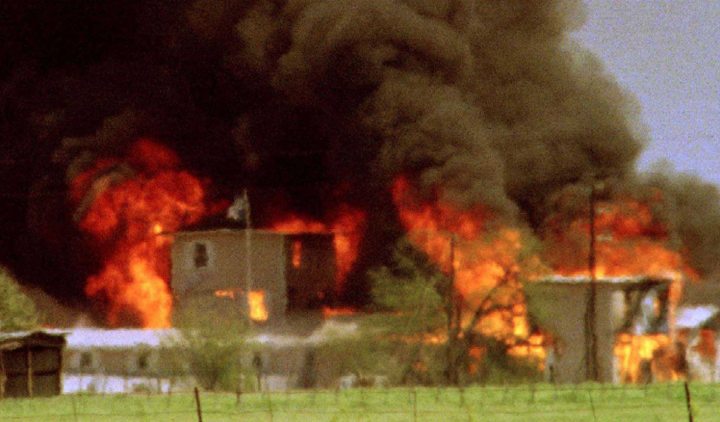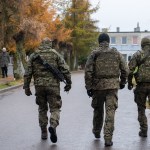World
Waco, Texas. Oklahoma City. The new age of terrorism.

April 19 has a specific cachet in American domestic terrorist lore. It is the date in 1993 when the FBI finally stormed David Koresh’s castle in Waco, Texas. It is also the date, two years later, on which Timothy McVeigh blew up a building in Oklahoma City, killing 164 Americans and, in retrospect, ushered in a brand new age of terrorism. By RICHARD POPLAK.
It’s difficult to say exactly when the moral calculus shifted, but there is an argument to be made for the fact that 19 April 1995 shifted the way we understood the world. When Timothy McVeigh, assisted by Terry Nichols and Michael and Lori Fortier, filled a Ryder truck with explosives and parked it in the Alfred P Murrah Federal Building (which housed, among other things, a crèche), he rejigged what the televised age of terrorism, which properly kicked off in the 1970s, would bring us in the future.
The terms of McVeigh’s plot—in which the Murrah building was chosen because of it was home to so many of the federal departments that he despised; in which the date referenced other atrocities he felt the Feds had bungled; in which the date referenced a Historical Event of Great Importance (in this case, the 220th anniversary of the American Civil War battles of Lexington and Concord); in which the building, with its glass cladding, would make for impressive prime time TV images—were boilerplate terrorist-ese. His narrative employed the language of terrorism, which shared a lexicon with television, especially as we inexorably moved into the 24-hour news cycle – terrorism’s boom years, if you will.

Photo: The exterior of the Alfred P. Murrah federal building in Oaklahoma City is seen from the air April 19, 1995, after it was devastated by a bomb. The judge in the Oklahoma City bombing trial said January 7 he would decide the sentence on convicted conspirator Terry Nichols after the jury could not reach a decision despite two days of deliberations. Federal Judge Richard Matsch said in court that the jury had told him it could not reach a unanimous decision on Nichols’ intentions. The jury convicted Nichols last month of conspiracy and involuntary manslaughter in the April 19, 1995 attack that killed 168 people.
Eighteen years later, I can almost recite the minutia of the Oklahoma City bombing by memory. The thinking at the time was that the 164 fatalities were somehow unprecedented, but they were only unprecedented in number, and not in intent. By far the greatest number of terrorist attacks (and the definition of “terrorism” has always been, and remains, a sticking point) have been perpetrated by American citizens of a paler hue – practicing Christians with a sense of mission, which largely relates to resetting the United States on its intended course. According to some of the history books, the first terror attack in America was the 1837 mob murder of Elijah P Lovejoy, the editor of the Alton Observer, who made the mistake of calling for abolition.
Was John Wilkes Booth –pro-slavery advocate and President Abraham Lincoln’s assassin – a terrorist? Was it possible to be a terrorist in 1865? Certainly, Lincoln’s murder made most Americans very sad, and caused them to worry for the future of their country, but were they properly terrorised? Did they hide in their homes and stockpile water? No, they got on with the business of being citizens, while a tiny percentage went on to perfect and hone the practice of terror.
Take the Haymarket affair, of 1866, which stirred up the right admixture of chaos and carnage, counts in this writer’s mind as the first proper terrorist attack. The bombing of a labour rally in Haymarket Square in Chicago, which inspired a fusillade of gunfire from local cops, had a definite ideological bent – the workers were demanding an eight-hour workday – and the resulting trial was a fiasco. Minus the TV cameras, the Haymarket affair hits all the right terrorist notes. The Murrah atrocity had a proper forebear in the bombing of the Los Angeles Times building in 1910, in which the pro-union brother McNamara killed 21 of the workers they were trying to advocate for.
The list is literally endless, depending on how you define terrorism. The word properly entered the vernacular in the 1960s, which was perhaps the golden age of American-made terror. Radical rightists handed the baton to radical leftists, who blew up post offices and courts and federal buildings. Jane Alpert was the decade’s poster girl – she was involved in eight separate bombings, and wrote Mother Right: A new feminist theory. The Vietnam War, and the social divisions it caused in American society, fired up a deep streak of murderous advocacy. The 70s brought the Puerto Rican separatist group Fuerzas Armadas de Liberacion Nacional, the Jewish Defense League, the Weatherman and, of course, the rise of the militant (but secular) Palestinian terror factions. Planes fell from the sky – although the bombing of civilian aircraft dates back to 1933, when a Boeing 247 was blown up above Indiana, for reasons unknown.
The above is, of course, a vastly incomplete history, mostly because until we define what terrorism is, we can’t write a history of it. McVeigh and company were commemorating the second anniversary of the terrible events that made Waco, Texas, famous. Was Waco an act of terrorism? Interestingly, those on the fringes of the American right would insist that it was – but one perpetrated by the government, rather than the Branch Davidians they were sent to quiet.
On February 28, 1993, the Bureau of Alcohol, Tobacco and Firearms attempted to serve a warrant at the Mount Carmel Centre in Waco, and a massive gun battle, which killed four officers and six members of the cult in question, ensued. Fifty days later, after a siege that played out on televisions screens across the world, the compound was stormed, and 76 Brach Davidians, including leader David Koresh, died in the consequent fire. The event was one of those that blew the lid off the American narrative – it exposed an underground that not only exists but thrives in the swathes of the country sandwiched between New York and Los Angeles. David Koresh was a chunk of the American soul, like it or not.
And so, the Oklahoma Bombings, is the ancestor of the Boston Marathon bombings, a story that is still unfolding as these words go to press. Boston may be a result of a local crazy, and organised foreign or domestic organisation, or something in between. Timothy McVeigh’s fingerprints are all over the incident, but McVeigh’s fingerprints are not his own. They belong to a long line of terrorists, who belong to a long line of anarchists, who belong to a long line of pro-slavery advocates. It’s a wacky American family that dates back almost to the Mayflower. Terrorism is a part of the democratic experiment, because it is tied to intimately to a free media that needs stories to sell. If the twin anniversaries of Waco and Oklahoma City tells us anything, they should tell us this – if we want to erase terrorism, we have to stop reading, watching, Tweeting. And to borrow a cliché: that would mean the terrorists have won. DM
Photo: The Davidians’ Mount Carmel compound near Waco, Texas, is shown engulfed in flames in this April 19, 1993 file photo. (Reuters)




















 Become an Insider
Become an Insider